Latin Cults
Cult of Fortuna Primigenia at Praeneste


Latin Cults
Cult of Fortuna Primigenia at Praeneste
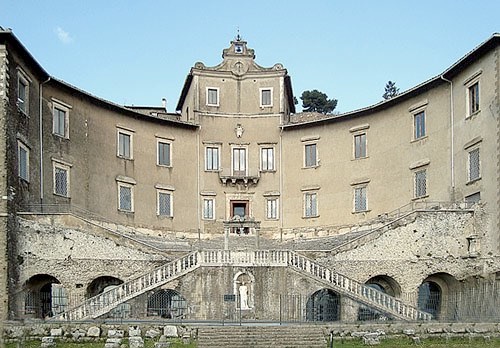
Palazzo Barberini (ca. 1630-40) and the remains of the Sanctuary of Fortuna Primigenia
Fortuna Primigenia at Praeneste

Sketch of a scene engraved on a bronze cista (late 4th century BC) from the necropoli della Colombella at Praeneste:
now inv. 13133, Villa Giulia Museum, Rome
From Sandra Gatti (referenced below, p. 68, Figure 103)
Evidence for an Oracular Cult at the Sanctuary
Fortuna Primigenia was, first and foremost, the goddess of the Latin city of Praeneste (modern Palestrina, some 40 km east of Rome). The most important evidence for her cult here comes from Cicero (ca. 45 BC):
“According to the annals of Praeneste, Numerius Suffustius, who was a distinguished man of noble birth, was admonished by dreams ... to split open a flint rock that was lying in a specified place. Frightened by the visions and disregarding the jeers of his fellow-townsmen, he set about doing as he had been directed. And so, when he had broken open the stone, the lots sprang forth, carved in ancient characters on oak. The site [where the stone was found] is fenced off in accordance with religious rules (locus saeptus religiose) to this day. It is hard by [the statue of] the child Jupiter (Iovis pueri), who is represented as sitting with Juno in the lap of Fortuna and reaching for her breast, which is held in the highest reverence by mothers. There is a tradition that, coincident with the finding of the lots, honey flowed from an olive tree that stood on the spot where the temple of Fortuna now stands [at the summit of the highest point of the sanctuary - see below]. The haruspices who had declared that those lots would enjoy an unrivalled reputation now gave orders that a chest should be made from this tree, and that the lots should be placed in the chest. These days, the lots are taken from their receptacle at the bidding of Fortuna. Tell me, what reliance can you put in these lots, which are shuffled at Fortuna’s nod and drawn by the hand of a child?”, (‘On Divination’, 2: 85, translated by William Falconer, at pp. 467-9).
Sandra Gatti (referenced below, at p. 68) observed that the scene engraved on a cista (late 4th century BC, sketched above) from the necropoli della Colombella at Praeneste almost certainly constitutes the earliest surviving evidence for the oracular cult at the sanctuary, albeit that there is no consensus as to exact nature of the scene that it represents: for example:
✴Filippo Coarelli (referenced below, at pp. 70-2) argued that the figure on the left was a young boy who had drawn a lot and was about to present it to a priest; while
✴Fausto Zevi (referenced below) argued that this figure depicted Numerius Suffustius discovering the lots used for divination.
The earliest surviving evidence for the existence of an oracular cult at the sanctuary was contained in a now-lost passage by Valerius Maximus: according to the epitome of it by Julius Paris (ca. 400 AD):
“[The consul Caius] Lutatius Cerco, who ended the First Punic War [in 241 BC], was forbidden by the Senate to consult the sortes Fortunae Praenestinae because they judged that public business should be conducted under national rather than foreign auspices”, (‘Memorable Doings and Sayings’, 1: 3: 2, based on the translation by David Shackleton Bailey, referenced below, 2000, at p. 45).
Thus, it seems that Cerco had intended, for some reason, to consult the oracle of Fortuna Primigenia at Praeneste , but had been forbidden to do so because the Senate considered hers to be a ‘foreign’ cult. Daniele Miano (referenced below, at p. 25) observed that, although the context in which Cerco wished to consult the lots of Fortuna Primigenia cannot now be recovered:
“... the anecdote definitely confirms that ... there was a functioning oracle of Fortuna based on lots at Praeneste [by 241 BC], and that this oracle was famous enough to attract people from other Italian towns, including Rome.”
The fasti Praenestini (ca. 8 AD), which were displayed in the forum of Praeneste, recorded that, on April 10th-11th:
“... sacrific]ium maximu[m]/ [fit] Fortunae Prim[i]g(eniae). Utro eorum die/ eius] oraclum patet, IIviri vitulum i(mmolant)”
“... a great sacrifice is offered to Fortuna Primigenia. On each of these days, the oracle is open. The duoviri sacrifice a calf”, (translation from the Attalus website).
Although the festivals recorded in these fasti are generally held at Rome, this one surely refers to an annual festival held at the sanctuary at Praeneste. According to Suetonius, the Emperor Tiberius (14-37 AD):
“... forbade anyone to consult soothsayers (haruspices) secretly and without witnesses. Indeed, he even attempted to do away with the oracles near the city, but forbore through terror at the divine power of the Praenestine lots; for, though he had them sealed up in a chest and brought to Rome, he could not find them until the box was taken back to [their original] temple”, (‘Life of Tiberius’ 3: 63: 1).
Meaning of the Epithet Primigenia
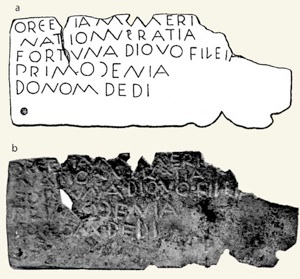
Inscription (CIL XIV 2863) from an unknown location in Praeneste
now in the Musée des Beaux-Arts de la Ville de Paris
From Annalisa Franchi de Bellis (referenced below, at Figure 1, p. 132)
The earliest surviving evidence for Fortuna’s epithet ‘Primigenia’ is in an inscription (CIL XIV 2863) from an unknown location at Praeneste (now in the Musée des Beaux-Arts de la Ville de Paris), which dates to the first half of the 3rd century BC: it is engraved on a bronze plaque and reads:
Orcevia Numeri 〈:uxor〉/ nationu(s) cratia
Fortuna Diovo(s) fileia (filiae)/ Primo((g))enia/ donom dedi
Daniele Miano (referenced below, at p. 21) translated this as:
“Orcevia, wife of Numerius, for the blessing of childbirth, offered (this) as a gift to Fortuna Primigenia, daughter of Jupiter’.
When this ancient inscription was discovered in 1882, it threw light on four inscriptions from the sanctuary itself that recorded much later offerings to Fortunae Iovis puero Primigeniae:
✴one (CIL I 3051) from the second half of the 1st century BC; and
✴three (AE 2007 314, CIL XIV 2862 and CIL XIV 2868) from the period 50-200 AD.
The ‘Diovo(s) fileia’ of the ‘Orcevia’ inscription indicated that the ‘Iovis puero’ of the four later ones also indicated that Fortuna Primigenia was so-called because she was was the firstborn child of Jupiter.
However, as we have seen, Cicero (ca. 45 BC) recorded that the sanctuary contained a statue of:
“... of the infant Jupiter (Iovis pueri), who is represented as sitting with Juno in the lap of Fortuna and reaching for her breast, which is held in the highest reverence by mothers”, (‘On Divination’, 2: 85, translated by William Falconer, at p. 467).
Furthermore, as Daniele Miano (referenced below, at p. 40) pointed out:
“Elsewhere [at ’On the Laws’, 2:28], Cicero [44 or 43 BC] also mentions an etymology of Fortuna Primigenia ‘from giving birth’ (a gignendo) ...”
Thus, it seems that Cicero followed a tradition in which the epithet Primigenia had the more obvious meaning of ‘primordial’, and that she was considered to be the mother (or, at least, the wet nurse) of both Jupiter puer (the child Jupiter) and the young Juno.
Jacqueline Champeaux (referenced below, at p. 48) referred to a reference by the poet Statius (ca. 90 AD) to:
“And if the Tirynthian shrine [i.e., the Sanctuary of Hercules Victor at Tibur] did not give other oracles, the sorores (sisters) of Praeneste could migrate”, (‘Silvae’, 1: 3: 80-1, translated by David Shackleton Bailey, referenced below, 2015, at pp. 47-9);
and suggested that the sorores of Praeneste were the two aspects of Fortuna there:
“... derived from the two [aspects of the Greek Mother-Goddess], Tyche, one the mother, the other the daughter, of Zeus-Jupiter ...”, (my translation). However, Annalisa Franchi de Bellis (referenced below, at pp. 130-1), who cited Rudolf Wachter (referenced below), argued that:
“... primigenius, as a designation of a first-born child is found only in later names of slaves and in the surnames of Greek and Latin freedmen.”
She therefore concluded that:
“[Fortuna] Primigenia is the first born goddess, the original, the primordial: [she is] not only the one who is ‘born’ first [i.e., created from nothing], but also the one who gives birth”, (my translation).
However, Daniele Miano (referenced below, at p. 22) argued that the evidence from the ‘Orcevia’ inscription could not be ignored, and that neither of the two apparently conflicting hypotheses [i.e., that Fortuna Primigenia was the firstborn child of Jupiter or that she was primordial, and thus the first of the gods to be created] could be discounted. His underlying thesis was that Fortuna, whether or not designated by any particular epithet, was a goddess who could mean different things to different people.
Fortuna Primigenia as a Goddess of Salvation
Daniele Miano (referenced below, at p. 27) also pointed out that surviving evidence suggests another way in which Fortuna was understood at Praeneste. For example, during the Second Punic War, the Praenestines remained in alliance with the Romans, even after Hannibal’s crushing victory at Cannae in 216 BC. In the following year, a garrison largely made up of troops from Praeneste found itself besieged by the Carthaginian army at the strategically important town of Casilinum (the later site of modern Capua) and, when they faced starvation and the Romans were unable to relieve them, they were forced to surrender. According to Livy, Hannibal allowed the survivors to be ransomed, and they:
“... returned in safety to Praeneste with their commanding officer, M. Anicius, who had formerly been a notary”, (‘History of Rome’, 23: 19: 17).
The safe return of at least some of their young men and the respect that they had won in the eyes of the Romans seems to have reinforced the civic pride of the Paenestines: according to Livy:
“The Senate decreed that the Praenestine troops should be granted double pay and an exemption for five years from further service. They were also offered the full Roman citizenship, but they preferred not to change their status as citizens of Praeneste”, (‘History of Rome’, 23: 20: 2).
Furthermore:
“To commemorate the event, [Anicius’] statue was set up in the forum of Praeneste, wearing a cuirass under his toga and with his head veiled. A bronze plate was affixed, with this inscription:
‘Marcus Anicius has discharged the vow he made for the safety of the garrison of Casilinum’.
The same inscription was placed beneath three other images (signa) in the temple of Fortuna”, (‘History of Rome’, 23: 19: 18).
Daniele Miano (referenced below, at p. 28) suggested that Livy’s account:
“... appears to show a connection between the goddess and salvation from a situation of extreme danger.”
Fabio Luci (referenced below, at p. 43) observed that the iconography of Ancius’ statue in the forum encompassed:
“... all the steps of [his] adventure ... : the citizen Anicius is shown by his togate status, awarded by his fellow citizens for his public service; the vow he made to bring back his soldiers is represented by his covered head; and ... his courage in the defence of Casilinum is represented by the cuirass.”
It seems likely that the signa in the temples were also statues, but it is not clear whether they were statues of Anicius, of Fortuna Primigenia, or of one or more other deities. However, we can almost certainly assume that Anicius had vowed that, if Fortuna would ensure that he and his men were saved and able to return to Praeneste, she would be honoured by the erection of signa in her sanctuary.
This hypothesis that Fortuna was regarded as a goddess of salvation is supported by Livy’s account of the military activity of the Roman consul Publius Sempronius Tuditianus in Bruttium in 205 BC, during the closing stages of the war. Things started badly: Hannibal ambushed his army near Croton and many of his men were killed before they reached the safety of their camp. However, he was able to summon reinforcements and engaged again with Hannibal’s forces on the following day. According to Livy:
“At the start of battle, he vowed a temple to Fortuna Primigenia, should he rout the enemy: his prayer was granted [when] the Carthaginians were routed and put to flight ...”, (‘History of Rome’, 29: 36: 8-9).
The Praenestine goddess had come to the aid of Romans once again, and her cult was duly introduced at Rome on 10th November 194 BC, when Sempronius’ new temple on the Quirinal was dedicated. As Eric Orlin (referenced below, 2010, at p. 181) observed, less that 50 years after the incident involving C. Lutatius Cerco (above):
“... Fortuna Primigenia moved from being a goddess whom the Senate did not trust [in relation matters of state], to [one who was given] a home on the Quirinal hill, inside the pomerium of Rome itself.”
Sanctuary of Fortuna Primigenia
Although the sanctuary seems to have been an ancient (probably archaic) cult site, the earliest evidence for the presence of a significant cult centre here is provided by two incidents discussed above:
✴the anecdote involving C. Lutatius Cerco in 241 BC; and
✴the erection of three signa here following the ransoming of the Praenestine survivors of Hannibal’s siege of Casilinum in 215 BC.
Another indication of the existence of an important sanctuary at Praeneste comes in 167 BC, when King Prusias of Bithynia arrived at Rome in order to secure his position with the Romans after their victory over his brother-in-law, King Perseus of Macedon. According to Polybius, who witnessed the fall of Macedonia and was appalled by Prusias’ obsequiousness:
“... on entering the Senate House, he stood in the doorway, ... bowed his head to the ground in adoration, ... [and addressed the Senate] with the words:
‘Hail, ye saviour gods’;
making it impossible for anyone after him to surpass him in unmanliness, womanishness and servility”, (‘Histories’, 30: 18: 4).
According to Livy:
“After congratulating [the Senate] on the victory, he enumerated his own [alleged] services [to the Romans] in the war, and asked permission to sacrifice ten full-grown victims [almost certainly to Jupiter] on the Capitol in fulfilment of a vow, and one to Fortuna at Praeneste, [claiming that] these vows had been made for the victory of Rome”, (‘History of Rome’, 45: 44; 8).
It seems that his mission was extremely successful and that, among other signs of favour, the Senate decreed that:
“ ...the victims for sacrifice and the other requisites, whether he wished to offer them at Rome or at Praeneste, should be supplied to [Prusias] at public expense, as in the case of the magistrates”, (‘History of Rome’, 45: 44; 15).
Daniele Miano (referenced below, at p. 31) suggested that:
“... Prusias probably considered [or, at least claimed to consider] Fortuna and Jupiter as saviour gods or, at the very least, connected them with the notion of salvation arising from the Roman victory over Perseus, and that it was in this spirit that he offered sacrifices to them.”
It is probably no coincidence that, in ca. 145 BC, Philotas of Epidamnos (in Illyria), the commander of the Ptolemaic garrison at Itanos on Crete, made a dedication (evidenced by an inscription OGIS 119 on a limestone stele) to Zeus Soter (Jupiter Saviour) and Tyche Protogeneia Aienaos (Fortuna Primigenia, the ever-flowing). As Daniele Miano pointed out (at p. 173), the epithet Protogeneia is unprecedented for Tyche (the Greek goddess of Fortune) or for any other Greek goddess. It seems that, during the 2nd century BC, the role that Fortuna Primigenia of Praeneste had played in saving the Romans and their Praenestine allies during the Second Punic War was appreciated in the Greek-speaking world.
Late Republican Sanctuary
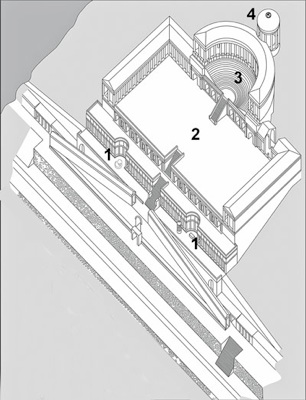
Reconstruction of the Temple of Fortuna Primigenia at Praeneste (ca. 100 BC)
1 = Terrazza degli Emicicli; 2 = Terrazza delle Cortine; 3 = Cavea; 4 = Temple
From Tesse Stek (referenced below, at p. 339, Figure 22:9)
Sandra Gatti (referenced below, at p. 62) observed that:
“We know almost nothing about [the structure of the sanctuary] before the last decades of the 2nd century BC, when [it was completely rebuilt], alongside the major urban and monumental reconstruction of the city ...”, (my translation).
She reiterated (at p.78) that:
“... epigraphic evidence proves, without a shadow of a doubt, that the complex [in its final form] was realised in the last decades of [the 2nd century BC], since the magistrates who were recorded in relation to [its] reconstruction] ... all belonged to the most important families of Praeneste, [and these families] almost completely disappeared after Sulla [took his revenge on the pro-Marian city in 82 BC]”, (my translation)
However, Sulla apparently respected the sanctuary: for example, Pliny the Elder recorded that:
“Mosaic pavements were first introduced in the time of Sulla; at all events, there is still in existence a pavement, formed of small segments, that he ordered to be laid down in the Temple of Fortuna at Praeneste”, (‘Natural History’, 36: 64).
This late Republican sanctuary, which remained in use into the Imperial period, stood on a huge superstructure in modern Via del Borgo, and was laid out on three inter-connected terraces cut into Monte Ginestro. It was subsequently subsumed by urban development, with the upper part used for the fortress and then the palace of the Colonna family before it became the site of a new palace built in the 17th century for the brother of Pope Urban VIII (Maffeo Barberini). As Benjamin Rouse (referenced below, 1t p. 14) observed:
“The allied bombings in Italy during 1944 destroyed part of the historic centre of Palestrina, yet offered a unique opportunity for scientific research; the medieval houses that had been built on top of the foundations of the sanctuary ... were made uninhabitable and could thus be cleared, enabling the systematic investigation of the ancient remains. Published in 1953, the report of the excavation and analysis of the complex by the archaeologist Giorgio Gullini and architect Furio Fasolo [referenced below] marks an important turning point in the study of the monumental sanctuaries of Latium, generating interest and providing new opportunities for comparison.”
Benjamin Rous then described the subsequent identification of eight sanctuaries in Latium that had been monumentalised in the late Republican period, at or near Aricia, Fregellae, Gabii, Lanuvium, Praeneste, Tibur, Tarracina and Tusculum. He observed (at p. 248) that they had all been built on a large scale on locations that could be seen from a considerable distance, and noted that:
“While the choice of impressive and highly visible sites for temples was not a new development, the amount of effort and the means used to achieve a true scenographical effect were a new development that can be placed firmly in the late Republican period, and in this sense constitutes an innovative element in sanctuary architecture. Never before had an attempt been made in Italy to construct building complexes comprising temples and secondary structures that formed a more or less organic whole. By making use of and altering the natural landscape, these sanctuaries were visually composed. In this respect, [they] can be placed in a wider development in the Greek-Hellenistic area displaying similar tastes.”
His diagram (Figure 24, at p. 117) showing the relative chronology of these monumentalisations places the sanctuary at Praeneste (last quarter of the 2nd century BC) at the temporal centre of this development.
Terrazza degli Emicicli
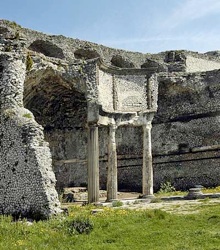
Terrazza degli Emicicli: remains of the eastern exedra
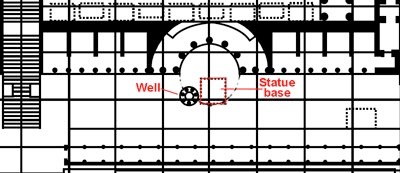
Plan of eastern part of the Terrazza degli Emicicli
Detail from Benjamin Rous (referenced below, Figure 38, at p. 175)
he first of these terraces is known as the Terrazza degli Emicicli, since its rear portico contained two symmetrically-placed semi-circular niches or exedrae. Sandra Gatti (referenced below, at p. 66) recorded that the base of a statue has been excavated in front of the eastern exedra, next to a deep well. She observed (at p. 67) that:
✴a statue base that survives in front of eastern exedra of this terrace had almost certainly belonged to the statue mentioned by Cicero, in which the infant Jupiter had been represented, alongside Juno, in the lap of Fortuna and reaching for her breast (the iconography of which is discussed below); and
✴the marble bust of a female (illustrated below), which was found at the bottom of the adjacent well, must have come from the figure of Fortuna in this statue.
As Benjamin Rous (referenced below, at p. 176) pointed out, the well was located on an imaginary circle encompassing the colonnade of the exedra. Sandra Gatti (referenced below, at p. 67) argued that:
✴the lower part, which was composed of squared blocks of tufa, probably belonged to an earlier phase of the sanctuary; and; and
✴the upper part, which was built using a technique known as opus incertum, probably represented an upward extension when the level of the terrace was raised during the rebuilding of the sanctuary in the late 2nd century BC.
She noted (at p. 66) that, in its new incarnation, the top of the well was enclosed in a tholos (small circular temple), the ‘walls’ of which comprised seven Corinthian columns, and argued (at p. 67) that tholos would have marked the place next to the statue of Jupiter puer where Numerius Suffustius found the lots of Fortuna, which, according to Cicero (above), is ‘fenced off in accordance with religious rules (locus saeptus religiose) to this day’.
Terrazza delle Cortine and Theatrical Cavea
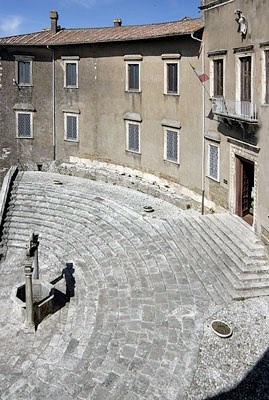
Cavea (theatre seating)
A double staircase from Terrazza degli Emicicli led up to the huge Terrazza delle Cortine. A double portico ran around the back and sides of the terrace, and the back portico was pierced at its centre by a staircase that led to the semi-circular theatrical cavea (seating area). A double portico that ran around its circumference (the remains of which are now inside Palazzo Barberini), probably obscured the view of the temple behind it, at least from the lower terraces. The present travertine steps of the cavea probably belong to medieval restoration following the destruction of the Colonna fortress here by Pope Boniface VIII in ca. 1300.
The cavea would have allowed an audience to sit in front of the temple, presumably to watch a spectacle of some kind. John Hanson 9referenced below, at p. 34) described it as :
“... a cavea-like staircase of seventeen steps ending in a relatively small ‘orchestra’, 10.5 meters wide at the front. There is [then] an immediate drop ... of 6.6 meters to the next level of the [Terrazza dele Cortine ... [It would have been] useless as a theatre in the ordinary sense of the word, since there is no possibility of completing it with either stage building or platform, and the ‘orchestra’ is too small for the development of any elaborate spectacle. Keeping in view the limitations in space and visibility imposed by the changes in level, one may conceive three different ways in which the steps could still function as a sort of theatron:
✴A simple ceremony or sacrifice or speech could be performed in the top ‘orchestra’ and witnessed by a fairly extensive number of spectators standing on the steps and in the portico above. Such a ceremony could be seen even from the front of the round [temple above].
✴A more extensive ceremony or pageant or play could be performed on the rectangular piazza below ... .
✴A third possibility is that the ‘spectaculum’ itself may have taken place on the semicircular stairs and colonnade, in the form of an array of important personages, priests and officials, who would thus be made eminently visible to persons on the lower terraces of the sanctuary.
Despite the impossibility of determining the exact use of this cavea at [Praeneste], it is highly probable that the steps were employed for spectacula of some nature.”

View southwards from the cavea and Terrazzo delle Cortine
Detail from Benjamin Rous (referenced below, Figure 37, at p. 174)
Benjamin Rouse (referenced below, at p. 106) also pointed out that the cavea:
“... could probably not have been used as an actual theatre, because of the absence of a [permanent stage in front of it], although the construction of a temporary scaenae [on the Terrazza delle Cortine] for scenic performances remains a distinct possibility. ... [However], the half-round form [might also have been included in the monumental design]:
✴... as an architectural element enhancing the scenographical qualities of the complex; or
✴... [for] cultic reasons.
He observed (at p. 174) that:
“Looking out towards the valley while standing on the central axis on the [Terrazza] delle Cortine and, even more so, in the centre of the cavea, the double colonnade of the [latter] seems to frame a symmetric landscape, with the Monti Lepini and Colli Albani each to one side. The symmetric composition of the landscape as framed by the architecture of the sanctuary thus emphasises the symmetry of the sanctuary itself, undoubtedly a visual effect intended by its builders.”
It is, of course, also possible that this view was of some cultic importance. I wonder whether (as Hanson suggested above), the ‘orchestra’ was the focus of this part of the sanctuary: it might, for example, have been the place where the great sacrifice was made annually to Fortuna Primigenia.
Temple
The remains of the circular temple at the summit are visible on the 2nd floor of Palazzo Barberini. This would have been the site of olive tree from which, according to Cicero (above), honey flowed when Numerius Suffustius found the lots that were used here at Fortuna’s direction. It was destroyed by Boniface VIII: according to Sandra Gatti observed (referenced below, at p. 70), records from this time record a circular temple covered by a cupola, similar to the Pantheon in Rome. This would have housed a cult statue of Fortuna Primigenia, which might have been made of gilded bronze: Pliny the Elder (ca. 79 BC) recorded that:
“The thickest kind of gold-leaf is known as ‘leaf of Praeneste’: it still retains that name from the excellence of the gilding upon the statue of Fortuna there”, (‘Natural History’, 33: 19).
Jupiter Puer
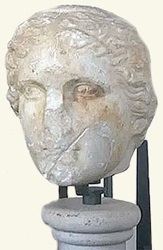
Presumed head of Fortuna (late 2nd century BC)
From the well in the west exedra of the Terrazza degli Emicicli
Now in the Museo Archeologico Nazionale di Palestrina
As noted above, Cicero (44 BC) referred to a statue of Jupiter puer in the sanctuary: specifically, he noted that the place in which the lots of Fortuna had been found:
“... is fenced off in accordance with religious rules (locus saeptus religiose) to this day. It is hard by [the statue of] the child Jupiter (Iovis pueri), who is represented as sitting with Juno in the lap of Fortuna and reaching for her breast, which is held in the highest reverence by mothers”, (‘On Divination’, 2: 85, translated by William Falconer, at pp. 467-9).
It is generally accepted that:
✴this statue group originally stood on the statue base that survives in front of the exedra of the eastern part of the Terrazza degli Emicicli; and
✴the over-life-sized female bust (late 2nd century BC) that was found in the adjacent well was from the figure of Fortuna.
Cicero’s wording in this passage suggests that the statue was associated primarily with the veneration of Jupiter puer.
Marion Bolder-Boos (referenced below, at p. 286) noted that Servius (4th century AD) equated Jupiter puer with Jupiter Anxur, the tutelary god of the colony of Tarracina (previously Volscian Anxur, which had been founded in 329 BC): Virgil (ca. 19 BC) had referred to:
“... Circe’s ridge [near Tarracina], over whose fields Jupiter of Anxur reigns, [together with] Feronia, rejoicing in her grove ...(‘Aeneid’, 7.799-800, my translation); and
Servius, in his commentary on this passage, explained that, in this area:
“... Jupiter puer, called Anxyrus, is worshipped, almost as the Greek ἄνευ ξυροῦ, which [means] without a razor, because he never cut his beard ... Iuno virgo (Juno, the virgin), who is called Feronia, [is also worshipped here]” (‘ad Aen’, 7.799-800, my translation).
Franz Altheim (referenced below, having referred (at p. 255) to this identification of Feronia with Juno Virgo at Tarracina, later (at p. 286) discussed examples of images of a mother goddess nursing two children, and noted that:
“Fortuna too, at least in the form in which she was worshipped at ... Praeneste, was the foster-mother of the two divine children, Jupiter Puer and Juno Virgo”.
In other words, it seems that the statue that Cicero described portrayed both Jupiter Puer and Juno Virgo in the lap of Fortuna, and that this association of Jupiter Puer and Juno Virgo reflected the association of their cults at Tarracina.
Livia Boccali (referenced below) explored the implications of this apparent link between Praeneste and Tarracina in her study of the sanctuary on Mount Sant' Angelo at Tarracina that had (like the sanctuary at Praeneste) been monumentalised in the late 2nd century BC. The main temple there is traditionally identified as the Temple of Jupiter Anxur, while the temple of Feronia was traditionally located at Punta di Leano, on a site mentioned by Horace (see below). One strand of here argument (set out at p. 187) was that the close association between Jupiter Anxur/ Jupiter puer and Feronia/ Juno virgo precluded the tradition that their respective temples were located:
“... practically at opposite points of the urban territory ...”
Some aspects of her analysis are relevant to the discussion here on the sanctuary at Praeneste. For example, she observed (at p. 184) that:
✴Servius (at ‘ad Aen’, 7.799-800, above) equated Feronia at Tarracina with Juno Virgo; while
✴Virgil (at ‘Aeneid’ 8: 563-4) described her as the mother of King Erulus of Praeneste, and Servius, in his commentary on this passage, described her as ‘Feronia Mater’ (at ‘ad Aen’, 8: 564).
She also noted that:
✴Horace had described a stream dedicated to Feronia at Punta di Leano outside Tarracina:
“At last, by ten o’clock we are barely landed and washed ... in thy stream, Feronia. Then we breakfast and, after crawling on three miles, climb up to Anxur, perched on her far-gleaming rocks”, (‘Satires’, 1: 5: 23-6, translated by Henry Rushton Fairclough, referenced below, at p. 67); and
✴the Pseudo Acronian scholia (probably 5th century AD), commenting on this passage, recorded that:
“Fanum Feroniae est in tertio miliario a Tarracina. Haec est Iovis Anxuris uxor, cuius et Virgilius meminit”, (at ‘Aeneid’, 7: 800)”, (reproduced by Livia Boccali, referenced below, at p. 221).
“The shrine of Feronia is [on Via Appia], at the 3rd milestone from Tarracina: [Feronia] is the wife of Jupiter Anxur, as remembered by Virgil”, (my translation).
Thus, Feronia could be both:
✴a virgin (Servius, ‘ad Aen’, 7: 800); and
✴a wife (Pseudo Acronian scholia) and mother (Virgil and Servius, ‘ad Aen’, 8: 564).
Boccali commented (at p. 184) that:
“The comparison with Praeneste's Fortuna Primigenia immediately presents itself. It seems that ... , also at Tarracina, a female goddess [this time, Feronia] presents herself in the double aspect of mater and virgo, and is connected to a Jupiter puer ...”, (my translation).
Although Jupiter Anxur/ Jupiter puer and Feronia/ Juno virgo were associated with each other at Tarracina, there is no surviving evidence that they were associated with Fortuna there. However, there is some slight evidence that Feronia and Fortuna Primigenia were associated with each other at Rome: under 13th November:
✴the pre-Julian fasti Antiates Maiores recorded:
“[Fer]on(iae), Fort(unae) Pr(imigeniae), [Pie]ṭati”; and
✴the fasti Fratrum Arvalium (ca. 30 BC) recorded:
“Feroniae in [Ca]mp(o), Fortun(ae) Prim(igeniae) in C(... ?)”
The reference to Fortuna Primigenia in the fasti Fratrum Arvalium is sometimes completed as Fortuna Primigenia in Capitolio, since it is possible that there had been an archaic temple of Fortuna on the Capitol. However, William Warde Fowler (referenced below), for example, completed it as Fortuna Primigenia in Colle, which would have referred to her temple on the Quirinal. Adam Ziolkowski (referenced below, at pp. 40-5) argued that this was the correct completion, and Daniele Miano (referenced below, at p. 105), citing Adam Ziolkowski, argued that the entry in the fasti Fratrum Arvalium:
“... must be firmly supplemented with in C(olle)”.
William Warde Fowler observed that:
“The conjunction [in Rome] of Feronia on this day with Fortuna Primigenia (in colle) is curious, as both were goddesses of Praeneste, where Feronia in legend [or, at least, according to Virgil] was the mother of [King] Erulus, a daemon with threefold body and soul, who had to be killed three times by Evander.”
Read more:
Luci F., “Monuments and Inscriptions in Republican Rome: Linguistic Framework for
Interpreting Art and Text”, (2019), thesis from Durham University.
Miano D., “Fortuna: Deity and Concept in Archaic and Republican Italy “, (2018) Oxford.
Gatti S., “Il Santuario della Fortuna Primigenia”, in:
Tavano G. (editor), “Palestrina e il Santuario della Fortuna Primigenia”, (2016) Pescara, at pp. 61-78
Fiasco A., “Praeneste, Fortuna Primigenia e il suo Santuario a Più di Settant' Anni dalla sua (Ri)scoperta”, in :
Merz J. (editor), “Il Santuario della Fortuna in Palestrina: Vedute ed Interpretazioni Attraverso i Secoli”, (2016) Palestrina, at pp. 81-95
Shackleton Bailey D. (translator), “Statius: Silvae”, (2015) , Cambridge MA
Bolder-Boos, M., “Tutelary Deities in Roman Citizen Colonies”, in
Stek T and Pelgrom J. (editors), “Roman Republican Colonization: New Perspectives from Archaeology and Ancient History” (2014) Rome, at pp. 279-94
Franchi de Bellis A., “L'Iscrizione Prenestina di Orcevia”, in:
Giacommelli R. and Bianchi A. (editors), “Le Lingue dell'Italia Antica Oltre il Latino: Lasciamo Parlare i Testi”, (2014) Milan, at pp. 111-37
Stek T., “Material Culture, Italic Identities and the Romanization of Italy”, in:
DeRose Evans J. (editor), “A Companion to the Archaeology of the Roman Republic”, (2013) Malden, MA, Oxford and Chichester, at pp. 335-53
Rous D., “Triumphs of Compromise: an Analysis of the Monumentalisation of Sanctuaries in Latium in the Late Republican Period (2nd and1st centuries BC)”, (2010), thesis of the Yniversity of Amsterdam
Klingshirn W., “Inventing the Sortilegus: Lot Divination and Cultural Identity in Italy, Rome, and the Provinces”, in:
Schultz C. and Harvey P. (editors), “Religion in Republican Italy” (2006) Cambridge, at pp. 137-61
Shackleton Bailey D. (translator), “Valerius Maximus: ‘Memorable Doings and Sayings’; Volume I, Books 1-5”, (2000) , Cambridge MA
Boccali L., “Esempio di Organizzazione delle Fonti Antiche per la Ricostruzione del Quadro della Vita Religiosa di una Città e del suo Territorio in Età Preromana e Romana: Tarracina”, Cahiers du Centre Gustave Glotz, 8:1 (1997) 181–222
Zevi F., “Note Prenestine”, in:
Froning H. et al. (editors), “Kotinos: Festschrift für Erika Simon” (1992) Mainz am Rhein, at pp. 356-65
Coarelli F., “I Santuari del Lazio in Età Repubblicana”, (1987) Rome
Wachter R., “Altlateinische Inschriften”, (1987) Bern
Champeaux J. , “Fortuna: Le Culte de la Fortune à Rome et Dans le Monde Romain: I: Fortuna Dans la Religion Archaïque”, (1982) Rome
Fasolo F. and Gullini G., “Il Santuario della Fortuna Primigenia a Palestrina”, (1953) Rome
Altheim F. (translated into English by by Mattingly H.), “A History of Roman Religion”, (1938) London
Rushton Fairclough H. (translator), “Horace: Satires; Epistles; The Art of Poetry”, (1926) Cambridge MA
Falconer W. (translator), “Cicero: On Old Age, On Friendship, On Divination”, (1923) Cambridge MA
Warde Fowler W., “Roman Festivals of the Period of the Republic”, (1899) London
Return to Rome in the Early Republic (509 - 241 BC)